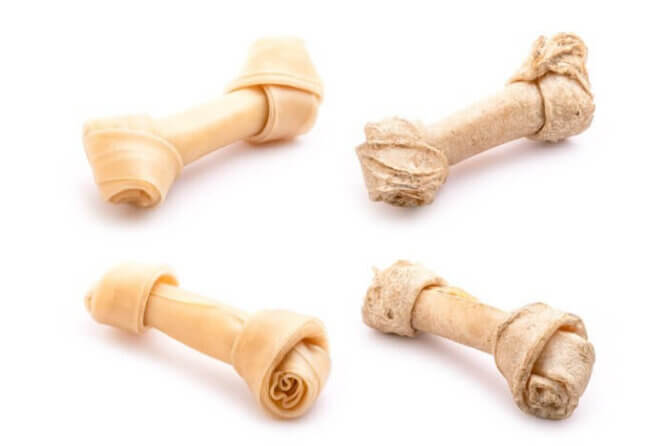Is Rawhide Bad for Dogs?

There are hundreds, if not thousands, of rawhide products available to buy for our dogs — in every shape and size. Dogs love them, people buy them, and pet shops continue to sell them… so they must be good right?
Not necessarily! There are several reasons why you should think twice before buying them for your dog.
Recently, rawhide has come under scrutiny for its potential risk to dogs’ health, despite being a popular treat for pet parents to give their dogs. Not only can the ingredients be questionable, but the chewing and digestion of rawhide can be dangerous due to its consistency and production methods.
The American Society for the Prevention of Cruelty to Animals (ASPCA) has even discouraged the consumption of rawhide for dogs. Read more to learn why it’s best to avoid rawhide when choosing a treat for your dog to chew on.
This article will teach you more about the risks of choosing rawhide as your dog’s treat.
What is rawhide?
Rawhide is the dehydrated inner layer of cow or horse skin (hide). The outer layer of hide is used by the leather industry to make shoes, clothes, bags, etc., while the inner hide is treated, bleached, artificially colored, and eventually manipulated into products, such as the dog chews you may be familiar with.
What are the dangers of rawhide?
Although rawhide provides a satisfying chew for a dog, and chewing is important for a dog’s dental health, there are multiple risks.
Rawhide is produced using chemicals
The process of turning animal rawhide into dog chews is lengthy. First, the hide is dipped into brines with a high salt content to slow down decay.
It’s then cleaned with detergent, degreasers, and sterilized with hydrogen peroxide before the hair and/or fat is removed using strong chemicals. More chemicals are used to separate the layers of skin.
Many rawhide chews are produced in China, and it may take several months for these preserved hides to reach the tanneries for their final processing.
When they reach the final stage, artificial colors or flavors are sometimes added in the final stages to make the rawhide more appealing, and glue may be used to create ‘fun’ shapes.
There was even a mass recall of several rawhide products a few years back due to chemical contamination: United Pet Group / United Pet Group Recall Expansion
It should be noted that there are some rawhide suppliers who claim to use more natural processing methods and if you are purchasing rawhide, try to find one manufactured in the USA.
Rawhides made in the United States can be harder to find, and pricier than your average rawhide chew, but the benefits are worth the cost.
However, the manufacturing process won’t mitigate the following risks…
Rawhide can cause intestinal obstruction
Rawhide was created to be chewed, not eaten, so it is highly indigestible. If your dog swallows large pieces of rawhide, it could very easily cause a blockage in their gastrointestinal tract and cause damage to the intestines.
Symptoms of this include vomiting and diarrhea, so if you notice your dog showing these symptoms, see a veterinarian immediately. Your dog may require surgery to have these pieces removed. Smaller pieces of rawhide may be broken down by stomach acid but could also cause a problem in large quantities.
Rawhide is a choking hazard
If large pieces of rawhide become lodged in a dog’s throat, this could become highly dangerous and potentially fatal. Rawhide becomes softer and stringier the more it is chewed, so it could easily break into pieces which are easier to swallow. This is when it could become stuck in the esophagus and cause a dog to choke.
Rawhide also becomes slimy when chewed which adds to the risk and makes it difficult to remove from the throat. It’s such a well-known choking hazard that some dog first aid courses include how to remove rawhide in their modules.
It doesn’t suit your dog’s type
As with most chews, your dog’s type will impact how safe it is. Although rawhide can break into smaller pieces, if your dog is a larger breed with a strong chew, they are likely to break off larger pieces which can be a choking hazard. Whereas it can be safer for smaller breeds who are soft chewers and can nibble on smaller pieces. If you are buying rawhide, choose appropriately sized treats and monitor closely.
Rawhide can damage a dog’s teeth
Some forms of rawhide are very dense and rigid, making them hard to break down for dogs. Although rawhide can be a given to dogs as a dental treat and to keep them entertained, hours of chewing a hard and brittle object could actually cause damage to their teeth.
Rawhide can become contaminated
Although unlikely, as rawhide is an animal-meat based product, it carries contamination risks, including with bacteria such as E.coli or salmonella.
What can I give to my dog instead of rawhide?
Rawhide is designed to keep dogs entertained and satisfy their urge to chew. There’s a whole range of healthier alternatives, such as sweet potato chews, carrots, and toys. For some options you could check out our Best Dental Chews and Best Dog Treats. Some are tougher and longer-lasting than others, and they come in a huge variety of shapes, sizes, and flavors.


